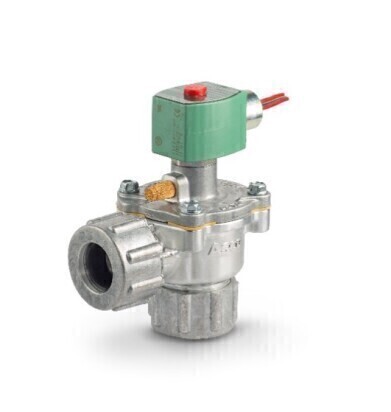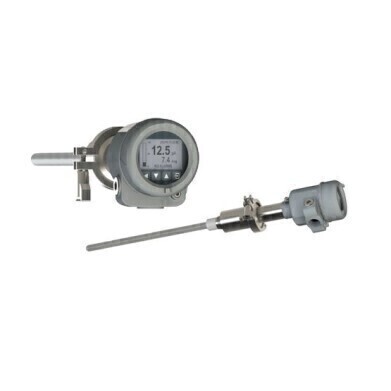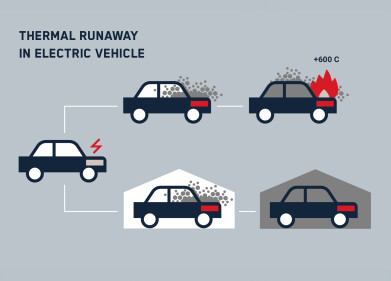-
 By upgrading pulse valves and integrating new valves, such as the ASCO™ Series 353 Pulse Solenoid Valve, facilities can realize energy savings while providing better dust control. (Image courtesy of Emerson)
By upgrading pulse valves and integrating new valves, such as the ASCO™ Series 353 Pulse Solenoid Valve, facilities can realize energy savings while providing better dust control. (Image courtesy of Emerson) -
.jpg) The AVENTICS™ Series AF2 Flow Sensor monitors air consumption in pneumatic systems, which can help operators identify leaks before they result in machine downtime. (Image courtesy of Emerson)
The AVENTICS™ Series AF2 Flow Sensor monitors air consumption in pneumatic systems, which can help operators identify leaks before they result in machine downtime. (Image courtesy of Emerson) -
 The ASCO Series DPT P152 is a robust and cost-effective particle sensor for detecting leaks in dust collection systems. (Image courtesy of Emerson)
The ASCO Series DPT P152 is a robust and cost-effective particle sensor for detecting leaks in dust collection systems. (Image courtesy of Emerson) -
.jpg) A critical sustainability tool, Movicon.NExT HMI/SCADA provides advanced analytics and visibility for connected devices and equipment across a plant. The highly modular and scalable platform can monitor dust collector systems and locate bag leakage in facilities. (Image courtesy of Emerson)
A critical sustainability tool, Movicon.NExT HMI/SCADA provides advanced analytics and visibility for connected devices and equipment across a plant. The highly modular and scalable platform can monitor dust collector systems and locate bag leakage in facilities. (Image courtesy of Emerson) -
.jpg)
Health & Safety
Adding Intelligence to Dust Collector Systems Improves Performance and Lowers Operating Costs
Jun 13 2023
Dust collector systems are an essential feature of waste management, ensuring the health and safety of the work environment, and satisfying the requirements of environmental regulations. For many waste management operations, dust collector systems’ antiquated processes pose challenges at a large scale. These include high energy costs, expensive consumption of carbon dioxide-producing compressed air and extra time and labor for system maintenance.
Due to these aging systems and processes, the trend of adding intelligence to dust collector systems is continuing to grow. The use of new technologies, like data-capturing sensors, sophisticated valves, and status and analytics software, is producing measurable benefits. These benefits include better performance, lower operating costs and reduced labor requirements — all of which support the goals of a safer, healthier and more productive work environment.
Addressing System Inefficiencies
Many areas within waste operations require dust collector systems, and these systems are a critical component of keeping the work area safe and protecting the environment. Examples of areas where dust collectors are used include air filtration applications such as cement, chemical, and food production facilities, waste incineration, material handling applications such as pneumatic conveying and handling of bulk solids, or finishing applications like blasting, sanding, and powder coating.
Dust collector systems often operate the same way for numerous years, resulting in inefficiencies that have made them ideal targets for updating with modern tools and technology. Some of the biggest challenges of outdated systems that can be addressed include:
Inefficient maintenance routines. General maintenance practice on dust collector systems includes manual checking of filter bags, which takes a lot of time and effort. This is due to not being able to locate where there are faulty solenoid valves, broken bags, or other maintenance issues and that the only indication of a problem occurring is often visual.
Frequent shutdowns. Prolonged system shutdowns can occur due to the high maintenance time required to ensure a functional system, costing critical time and dollars at the plant level.
Greater labor demand. Manual maintenance and shutdown troubleshooting consume more time and attention from personnel during a period when labor is already in short supply.
Increased energy use and carbon emissions. There is much opportunity to optimize the efficiency and functionality of dust collector systems. For example, timer-based pulsing results in over-pulsing the valves and cleaning the filters when it is not necessarily needed. This wastes energy and compressed air and can harm the filter bags themselves. Additionally, this overruns the compressors, which produces carbon dioxide emissions. An alternative is switching to differential pressure or particulate-based pulsing which pulses only when conditions indicate that cleaning is needed. This optimizes functionality and is more sustainable.
These challenges create a domino effect of inefficiency: inefficient cleaning of the filters bags, and the system demands more time, energy and resources to mitigate the effects. Digitizing and automating the system break this inefficient and potentially wasteful cycle.
Solving Challenges by Adding Intelligence
Two of the primary ways companies are resolving dust collecting issues are by adding sensors to the system to capture data and by automating tasks like pulse cleaning. Data can help an operations manager see the real-time status of the dust collector system and measure its impact on the plant’s larger ecosystem. Data can be used to calculate the precise timing and location of maintenance tasks while intelligent automation can optimize system functionality for a more efficient dust collector system.
A dust collector system is a data gold mine. Sensors can extract such metrics as system particle level, hopper dust levels, blower current, dusty air temperature, the difference in differential pressure between pre- and post-filter chamber, and air/gas tank pressure.
This data can then be leveraged by diagnostic software to provide valuable insights into performance, including the location of filter leaks and solenoid failures by row. It can also provide individual device health diagnostics. A programmable logic controller (PLC) can then use this information to control the system for optimal performance.
For example, all of a dust collector system’s controls can be compiled into one PLC. Using the data collected by a particle sensor, the PLC knows when the dust bags need to be cleaned and when to pulse the valve. This reduces compressed air usage by only pulsing when necessary. This process can be made even more efficient by updating the pulse valve with a modern valve that delivers extremely fast opening and closing times. Faster opening and closing reduces the amount of compressed air that is wasted while the valve is operating. Altogether, these enhancements can lower compressed air consumption and reduce CO2 emissions.
Furthermore, dust collector system data can be measured, displayed and stored using HMI or SCADA software. This provides an accessible platform for operators and technicians to review the status and performance of the system in real time. Some SCADA software can also display multiple dust collector systems across one or multiple plants, and the information can be accessed locally or via a web browser. Personnel can then receive alerts when the system identifies an issue or when maintenance is due. Another key feature is generating historical reports to satisfy government regulations posing restrictions on plant energy usage, for example.
The Benefits of Technology and the Future of Dust Collectors
Applying sensors, controllers, software and overall intelligence to a dust collector system can result in real savings, and many benefits are achievable with the introduction of intelligent components. The digital transformation of the dust collector industry will take time to reach its full capacity, but the evolution of these systems across OEMs and end users is already apparent. The future of dust collectors looks like the future of all industrial equipment: fully automated, optimally efficient and effectively participating in the effort to lower carbon emissions.
Digital Edition
AET 28.3 September 2024
September 2024
Business News - ENVEA announces acquisition of APAQ Group - SICK and Endress+Hauser sign strategic partnership - Efforts to curb gas flaring intensify amid environmental concerns Air Monito...
View all digital editions
Events
WEATHER • CLIMATE • WATER / EARTH OBSERVATIONS / GREEN ECONOMY
Oct 29 2024 St. Petersburg, Russia
Oct 30 2024 Hong Kong
Nov 05 2024 Toronto, Canada
Nov 05 2024 Rimini, Italy
Nov 06 2024 Ho Chi Minh City, Vietnam


















